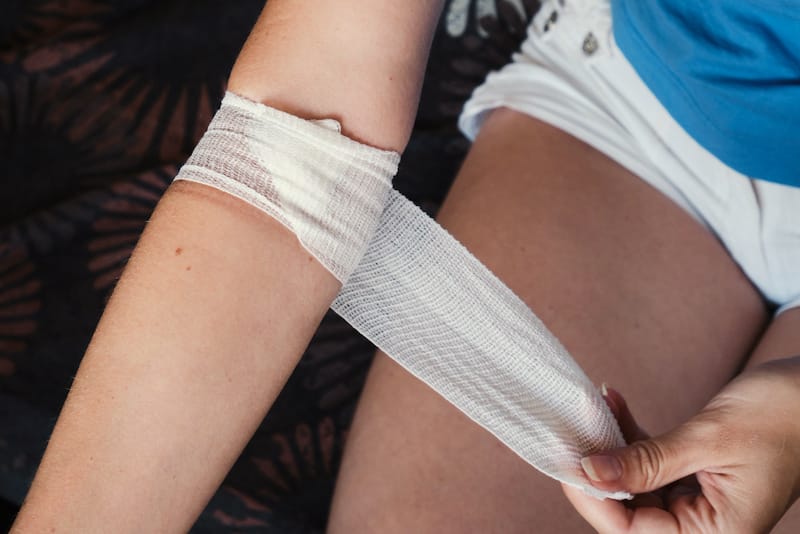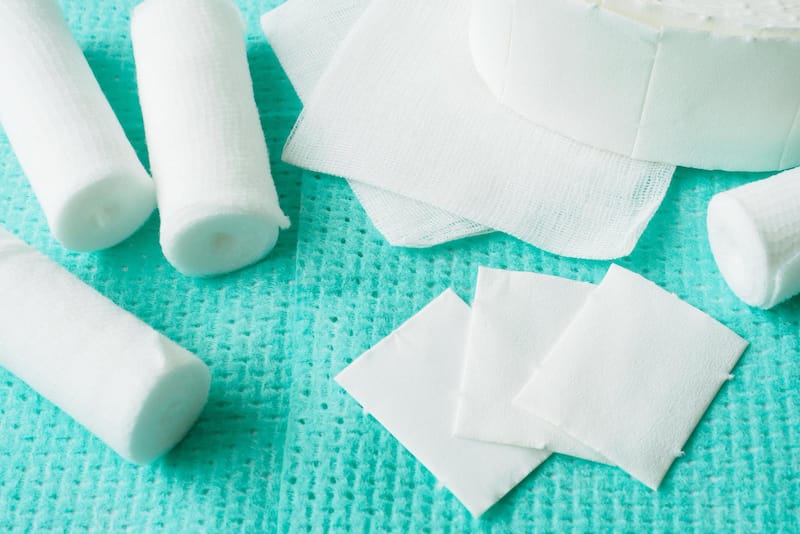To remove a bandage stuck to the wound, you can apply a cotton ball dipped in warm water or oil to remove the adhesive of the bandage. You can also use ice cubes in a cloth to get the adhesive brittle. If using rubbing alcohol to remove the dressing, remember to not apply it directly to the wound, or it will sting. The bandage stuck needs to be carefully removed to avoid reopening the wound or preventing it from getting infected. Using an antibiotic ointment, depending on the injury, before applying a bandage can prevent it from getting stuck to the wound again and help it heal.
When you’re wounded, applying a bandage helps cover the skin, prevent getting infected, and keep new skin and other cells alive.
Using a dressing is essential, but if done wrong, it can stick to the wound, causing a problem when it comes time to remove it.
A stuck piece of gauze can cause a lot of pain to the person, and it can’t be removed like a wax strip because you might risk reopening the healing wound.
So when it comes to removing a stuck bandage, you’ve to use a few tricks to get it safely removed. Let’s take a look at these tips!
How to remove a bandage stuck to the wound?

No matter the wound applying a bandage always helps heal the wound faster while protecting it from getting infected.
Removing a stuck bandage can be tricky. It also depends on the type of wound you have and how deep it is. More minor injuries can be covered with a regular band-aid and heal faster within 2-3 days.
A severe surgical wound like stitches needs a more careful and thorough dressing and must be covered for longer.
If the dressing procedure isn’t done right, it can stick to the wound as it dries up, making it painful to remove.
Though tricky, here are five simple ways to loosen up the bandage carefully without reopening the wound:
1. Apply water
Applying water to the adhesive bandages can help them remove faster because water can weaken the adhesive and get it unstuck.
Bandages that don’t have adhesive can be removed when water is applied, getting them unstuck from the dried wound.
Please don’t put a lot of water but get a cotton ball wet and dab it slightly over the bandage to get it unstuck.
You might not succeed at first, and you’ll need a lot of patience to slowly and gradually get things separated.
2. Applying oil or cream
If the water doesn’t work for you, using a different method such as applying oil can also lubricate the area and get things free.
You can use cream, lotion, or petroleum jelly, whichever is available to you.
People use different types of oil, such as baby oil and olive oil, and whichever works for you can be used.
Get a cotton ball or cotton swab and sab it slightly over the bandage until it’s entirely loosened. You can see when it’s about to come off.
3. Rubbing alcohol
You can try using rubbing alcohol to remove the stuck bandage. Do not pour it out directly on the wound but take a cotton swab and apply it to the dressing.
If you try to use it directly on the wound, it’ll sting a lot, speaking from experience, so always apply it to the bandage and in smaller quantities. It’ll take time, but it’ll help slowly dissolve it.
Rinse your skin or wipe clean any residue of rubbing alcohol because it can dry out your wound. Dry wounds take longer to heal, and you don’t want that!
4. Ice it out
This might sound weird, but rubbing ice on the adhesive bandage can also get it unstuck. The ice will help the adhesive freeze and remove the dressing without any pain.
Don’t try applying ice directly but take 2-3 cubes in a cloth and then use it to put on the bandage. If you have a cold compress at home, it’s best to apply it to the dressing.
Preventing bandage from getting stuck to wound

The important thing is to apply the bandage in the right way to avoid getting to the point where it’s stuck to your wound.
It’s painful and time-consuming to get a bandage unstuck, but it also risks reopening your wound, making all your efforts futile. It can make the injury more severe than before.
So, once you get your bandage unstuck, following these steps can help:
- Wash your hands before you try to dress a wound. Unclean hands can make your injury infected.
- If there’s bleeding, apply pressure on the wound with a gauze or clean cloth to stop the bleeding. Don’t check in between and keep at it for 15 minutes. If bleeding still doesn’t stop, go see a doctor.
- Clean your wound with soap and water and dry it with a clean cloth or gauze pads. Avoid using a fibrous clean towel as the fibers can get stuck to the wet wound.
- To prevent the bandage from sticking, applying an antibiotic ointment is essential. Antibiotic ointments are needed for quick healing as it creates a moist healing environment that has been clinically proven to aid and speed up the natural wound healing process. But it also depends on the type of wound if it’s required or not.
- The last step is to change the bandage daily. Every 24 hours, you should change your dressing to promote healthy and faster healing. This way, you can also check if the wound is healing correctly or infected.
If the bandage gets dirty or gets wet, change it immediately as it can get the wound infected. Of course, this is just a general way of changing a bandage and helping dress a wound.
Depending on the severity of your injury, determine what kind of wound dressings would be required to minimize the chance of getting it stuck.
But applying an ointment helps keep the wound moist and stops the bandage from sticking.
FAQs
Should I remove the dressing stuck to the wound forcefully?
Removing a stuck dressing can result in threats to skin integrity, which includes skin tears or a reaction such as the formation of cysts.
It can cause the wound to reopen and cause significant pain, and it can delay the healing of the injury and increase the risk of infection.
Is my wound healing or infected?
If your wound is infected, you’ll experience the skin feeling warm even after days of dressing it, which indicates the signs of infection.
Apart from redness and swelling, you might also experience discharge and pain. In severe cases, one might even get a high fever, depending on the severity of the wound.
A wound is healing when there’s sharp shooting pain in your wound area, which means you’re getting sensations back in your nerves.
When you change your bandage daily, you can see if there are visible signs of infection or not.
Does a wound heal faster covered or uncovered?
A wound heals faster when it’s covered because it needs a moist environment to heal.
Leaving an injury uncovered will dry out the skin cells and form a scab which can increase the pain and slow down the healing process.
You apply an antibiotic cream on the wound before covering it with a bandage so the injury doesn’t dry out and remains moistured to heal.
Does sleeping help heal a wound faster?
Sleep does indeed helps heal your wound faster, more than you think.
It supports more than eating right, and this is why you would see your body automatically requires more sleeping and bedrest when you have a common cold.
While medications help heal, the most important thing is good sleep, between 7 to 9 hours in a day.
Do I always need to apply antibiotic cream to the wound?
While using an antibiotic cream does aid in the healing of a wound by keeping it moisturized and prevent it from drying out, not every injury needs it.
Most scrapes and cuts heal without using an ointment, and it depends on the nature of the wound if it requires an application of antibiotic cream.
If it does, you should apply a thin layer as it prevents the bandage from sticking to the wound.
To summarise
A stuck bandage to the wound can be quite a painful situation. You can’t remove it forcefully, or it may cause the wound to reopen, get infected, or cause tissue damage.
There are many easy ways to remove the stuck bandage when there’s adhesive involved. Even if the gauze is stuck to the wound, the best thing would be to use water or oil on the dressing to get the two separated.
A bandage usually gets stuck when you forget to apply an ointment on the wound. So dressing up is essential, and ignoring this important step will always make your bandage stuck to the injury.


